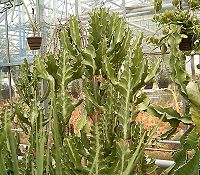Difference between revisions of "Euphorbia lactea"
m (1 revision(s)) |
|||
| Line 1: | Line 1: | ||
| + | {{Inc| | ||
| + | Euphorbia lactea, Haw. (E. havanensis, Hort., at least in part). Fig. 1445. Similar to E. antiquorum, but with a white-marbled area running through the middle of each face of the branches. E. Indies.—One of the most common succulent euphorbias in cult., of fine candelabra form, and making rapid growth. The euphorbias grown for hedges in Fla., W. Indies, etc., are chiefly this species, though some may be E. antiquorum. It is often confused with E. Hermentiana. Cristate forms are in the trade as E. lactea monstrosa and E. havanensis cristata, though these should perhaps be referred to E. antiquorum. | ||
| + | }} | ||
[[Image:Cactus tronc kourou.jpg|thumb|left|300px|[[Euphorbia lactea]] in [[Kourou]], French Guiana.]] | [[Image:Cactus tronc kourou.jpg|thumb|left|300px|[[Euphorbia lactea]] in [[Kourou]], French Guiana.]] | ||
{{Taxobox | {{Taxobox | ||
Revision as of 09:40, 1 October 2009
Read about Euphorbia lactea in the Standard Cyclopedia of Horticulture
|
|---|
|
Euphorbia lactea, Haw. (E. havanensis, Hort., at least in part). Fig. 1445. Similar to E. antiquorum, but with a white-marbled area running through the middle of each face of the branches. E. Indies.—One of the most common succulent euphorbias in cult., of fine candelabra form, and making rapid growth. The euphorbias grown for hedges in Fla., W. Indies, etc., are chiefly this species, though some may be E. antiquorum. It is often confused with E. Hermentiana. Cristate forms are in the trade as E. lactea monstrosa and E. havanensis cristata, though these should perhaps be referred to E. antiquorum.
|
| Euphorbia lactea | ||||||||||||||||||||||
|---|---|---|---|---|---|---|---|---|---|---|---|---|---|---|---|---|---|---|---|---|---|---|
 | ||||||||||||||||||||||
| Plant Info | ||||||||||||||||||||||
|
| ||||||||||||||||||||||
| Scientific classification | ||||||||||||||||||||||
| ||||||||||||||||||||||
| Binomial name | ||||||||||||||||||||||
| Euphorbia lactea Haw. | ||||||||||||||||||||||
Euphorbia lactea (Mottled Spurge, Frilled Fan or Elkhorn) is a species of spurge native to tropical Asia, mainly in India.[1][2]
It is an erect shrub growing up to 5 m tall, with succulent branches 3-5 cm diameter, ridged, with a triangular or rhombic cross-section; the ridges are spiny, with short spines up to 5 mm long. The leaves are minute, and soon deciduous.[2] All parts of the plant contain a poisonous milky latex.[3]
It is used medicinally in India.[4] It is widely grown as an ornamental plant, both in the tropics, and as a houseplant in temperate regions; a number of cultivars have been selected for ornamental use, notably 'Cristata' with frilled branching.[2][5] Other colloquial names include Candelabra spurge, Candelabrum tree, Candelabra cactus, Candelabra plant, Dragon bones, False cactus, Hatrack cactus, Milkstripe euphorbia, Mottled candlestick.
References
- ↑ Germplasm Resources Information Network: Euphorbia lactea
- ↑ 2.0 2.1 2.2 Huxley, A, ed. (1992). New RHS Dictionary of Gardening. ISBN 0-333-47494-5
- ↑ Poisonous plants: Euphorbia lactea
- ↑ Plant of the Week.org Euphorbia lactea
- ↑ Pacific Island Ecosystems at Risk: Euphorbia lactea
